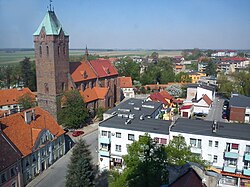Pitschen
| Byczyna | |||
|---|---|---|---|
 |
|||
|
|||
| Coordinates: 51°7′N 18°13′E / 51.117°N 18.217°E | |||
| Country |
|
||
| Voivodeship | Opole | ||
| County | Kluczbork | ||
| Gmina | Byczyna | ||
| Area | |||
| • Total | 5.79 km2 (2.24 sq mi) | ||
| Elevation | 197 m (646 ft) | ||
| Population (2006) | |||
| • Total | 3,677 | ||
| • Density | 640/km2 (1,600/sq mi) | ||
| Postal code | 46-220 | ||
| Website | http://www.byczyna.pl | ||
Byczyna [bɨˈt͡ʂɨna] (Latin: Bicina, Bicinium, German: Pitschen) is a town in Kluczbork County, Opole Voivodeship, Poland, with 3,708 inhabitants (2004).
The town of Byczyna was first mention in 1054 when it temporarily served as the capital of the Bishopric of Wrocław. After the loss of the Silesian duchies by the kingdom of Poland in the early 14th century Pitschen was for centuries a border town (near the border to Poland) and located north of Kluczbork and Rosenberg in Upper Silesia. The battle (Battle of Pitschen) took place near Byczyna between Maximilian III, Archduke of Austria, who was elected as king of Poland, and Sigismund Vasa who also was elected as king, on January 24, 1588. Maximilian was defeated. He surrendered and went to imprisonment. The German author Gustav Freytag reports in his memories about yearly border violations at Byczyna.
Ramparts in Byczyna, 15th century
"German" tower gate
The Saint Nicolaus evangelic church
Coordinates: 51°07′N 18°13′E / 51.117°N 18.217°E
...
Wikipedia



